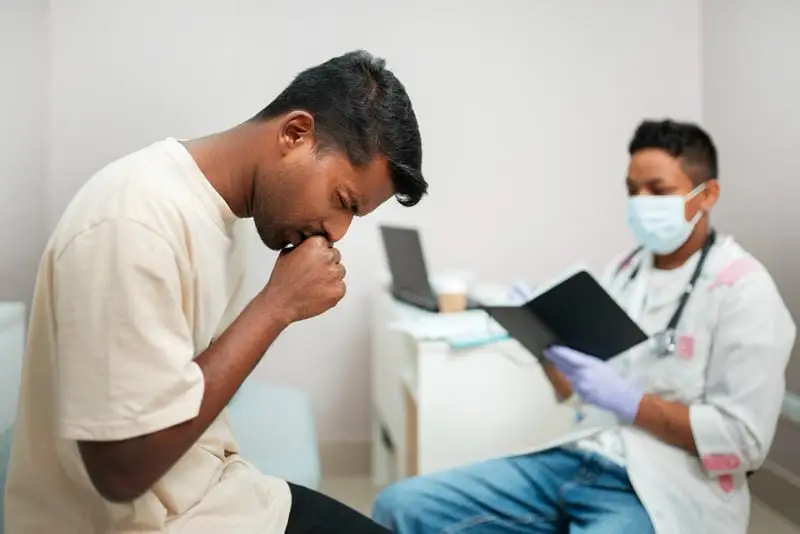- Published on: Jan 24, 2025
- 3 minute read
- By: SecondMedic Expert
Guillain-Barre Syndrome - Symptoms And Causes
Guillain-Barré syndrome (GBS) is a rare but serious neurological condition in which the body’s immune system mistakenly attacks the peripheral nervous system. This condition can lead to muscle weakness, numbness, and even paralysis in severe cases. Understanding Guillain-Barré syndrome symptoms, causes, and treatment options is crucial for early detection and effective management.
Guillain-Barré Syndrome Symptoms
The symptoms of Guillain-Barré syndrome typically begin with mild sensations of tingling or numbness in the hands and feet. These early signs of Guillain-Barré syndrome may quickly progress to more severe issues, including:
-
Muscle Weakness: Starting in the legs and spreading to the upper body, this weakness can become so severe that mobility is significantly impaired.
-
Reflex Loss: Deep tendon reflexes, such as the knee-jerk response, are often diminished or absent.
-
Pain: Many individuals experience sharp or cramping pain, particularly in the lower back.
-
Difficulty with Eye or Facial Movements: Symptoms may include difficulty speaking, chewing, or swallowing.
-
Respiratory Problems: In some cases, Guillain-Barré syndrome and respiratory failure become significant concerns, necessitating immediate medical intervention.
-
Autonomic Dysfunction: Irregular heart rhythms, blood pressure fluctuations, and other involuntary functions can be affected.
Guillain-Barré Syndrome Causes
The exact causes of Guillain-Barré syndrome are not fully understood. However, it is widely believed that the syndrome is triggered by an overactive immune response to an infection or other environmental factors. Common Guillain-Barré syndrome causes and risk factors include:
-
Viral Infections: Conditions such as influenza, Zika virus, and Epstein-Barr virus have been associated with GBS.
-
Bacterial Infections: Campylobacter jejuni, a bacterium often linked to food poisoning, is a common trigger.
-
Vaccinations: Although extremely rare, certain vaccines have been linked to GBS.
-
Surgical Procedures: Some individuals may develop Guillain-Barré syndrome following surgery.
-
Other Risk Factors: A history of autoimmune disorders or genetic predispositions may increase the risk.
Guillain-Barré Syndrome Progression Stages
Guillain-Barré syndrome progression stages typically unfold in three distinct phases:
-
Initial Stage: Lasting 1-4 weeks, this stage includes the rapid onset of Guillain-Barré syndrome symptoms such as weakness and numbness.
-
Plateau Stage: Symptoms stabilize but remain severe. This stage can last several weeks.
-
Recovery Stage: Gradual improvement begins, although Guillain-Barré syndrome recovery time can vary significantly between individuals, often taking weeks to months.
Guillain-Barré Syndrome Diagnosis
Diagnosing Guillain-Barré syndrome requires a thorough clinical evaluation. Physicians rely on specific Guillain-Barré syndrome diagnosis criteria, which include:
-
Patient History: Recent infections or medical procedures may provide crucial clues.
-
Neurological Examination: Reflexes, muscle strength, and sensory responses are assessed.
-
Electrodiagnostic Tests: Nerve conduction studies (NCS) and electromyography (EMG) help identify nerve damage.
-
Lumbar Puncture: Testing cerebrospinal fluid (CSF) can reveal elevated protein levels, a hallmark of GBS.
Early diagnosis is essential for effective treatment and to prevent complications like Guillain-Barré syndrome and respiratory failure.
Guillain-Barré Syndrome Treatment
Treatment for Guillain-Barré syndrome focuses on managing symptoms and speeding up recovery. The primary Guillain-Barré syndrome treatment options include:
-
Plasma Exchange (Plasmapheresis): This procedure removes harmful antibodies from the blood.
-
Intravenous Immunoglobulin (IVIG): High-dose immunoglobulin therapy helps neutralize the antibodies attacking the nervous system.
-
Supportive Care: Ventilatory support may be needed in severe cases, along with physical therapy to aid rehabilitation.
Guillain-Barré Syndrome Prognosis
The prognosis for Guillain-Barré syndrome varies depending on the severity of the condition and the timeliness of treatment. While most individuals recover fully, Guillain-Barré syndrome prognosis can include long-term complications such as:
-
Persistent Weakness: Some patients may experience lingering muscle weakness.
-
Nerve Damage: Chronic nerve pain or numbness can occur in rare cases.
-
Recurrence: Although uncommon, some individuals may develop Guillain-Barré syndrome again.
Guillain-Barré Syndrome Recovery Time
Guillain-Barré syndrome recovery time can range from a few weeks to several months. Factors that influence recovery include:
-
Age: Younger individuals generally recover faster.
-
Severity: Severe cases with extensive nerve damage may take longer to heal.
-
Timely Treatment: Early intervention is key to minimizing long-term effects and shortening recovery time.
Conclusion
Guillain-Barré syndrome is a challenging condition that requires early recognition and prompt treatment. By understanding the symptoms, causes, and treatment options, individuals can better manage this syndrome and improve their outcomes. If you or a loved one suspect Guillain-Barré syndrome, consult a healthcare professional immediately. Early diagnosis and treatment are critical for a full recovery.
Read FAQs
A. Early signs include tingling or numbness in the hands and feet, muscle weakness, and loss of reflexes. These symptoms may progress quickly if untreated.
A. Guillain-Barré syndrome is diagnosed using clinical evaluation, nerve conduction studies, electromyography (EMG), and cerebrospinal fluid (CSF) analysis.
A. Recovery time varies but typically ranges from a few weeks to several months. Early treatment can significantly speed up the recovery process.









